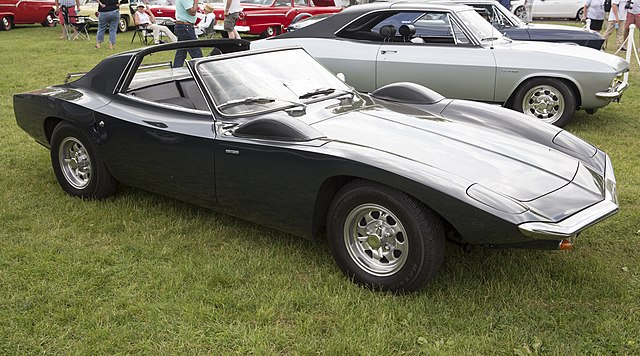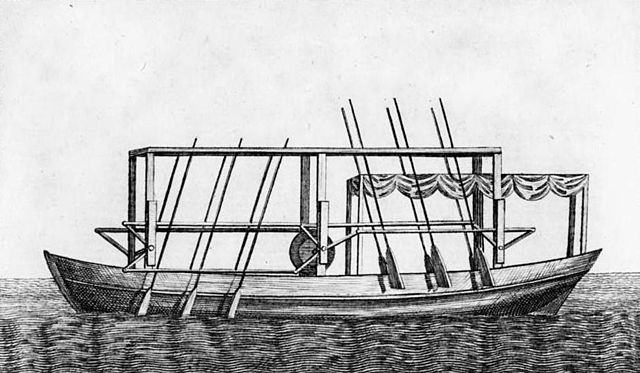August 4 is the birthday of John Fitch. He was a fighter pilot in WWII, based in north Africa. He and his squadron slept in tents, but being fighter pilots themselves, they felt pretty vulnerable to enemy fighter planes that could strafe the camp with machine gun fire. They didn’t have many resources to protect themselves, but on an airfield in north Africa they did have two things: empty fuel drums and sand. Lots of sand. So they would surround the tents with empty fuel drums and fill them with sand.
If you’ve driven on freeways in the US, you’ve seen the yellow barrels arranged at the end of a guard rail or around some sort of bridge abutment or other barrier that would be very bad to run into with your car at highway speed. Just like those fuel drums in north Africa all those years ago, they’re full of sand — or actually, the ones at the back are full of sand; the ones in front are less full. The idea is that if a speeding car impacts them, they dissipate the energy and slow the car down gradually enough that nobody is hurt. They’re called Fitch Barriers because after the war, John Fitch decided to improve automobile safety. Nobody believed his claim that plastic barrels of sand would save anything, so he paid to install the system himself, installed high-speed cameras in and around a car, and drove into them himself at high speed.
Fitch wasn’t a stranger to driving fast. After WWII he started racing an MG at tracks around New England. By 1950, he had built the Fitch Model B, a racing car he assembled out of various other cars. He was pretty successful, and started competing in races outside the United States. He won a big race in Argentina in 1951. That convinced a wealthy racing-team owner, Briggs Cunningham, to back him. Cunningham had his own racing cars built (called Cunninghams, to nobody’s surprise) and the team — and particularly Fitch — kept winning. That caught the attention of the major racing teams, and before long Fitch was driving for the Porsche racing team, and then Mercedes-Benz, which in those days had teams in several types of auto racing.
Fitch was a driver for Mercedes-Benz in the 24-hour race at Le Mans, France, in 1955, when one of his co-drivers (Pierre Levegh) was involved in what is still the worst disaster in the history of auto racing. It was a multiple-car crash at about 130mph that killed Levegh and 83 spectators. One of the cars involved exploded, and since it was made of flammable magnesium, it continued to burn white-hot. The firefighters at the track did exactly the wrong thing to burning magnesium; they sprayed it with water. That made the fire worse and sprayed the remaining crowd with hot magnesium. 180 more people were hurt. Don’t spray water on a magnesium fire.
That disaster is why Mercedes-Benz stopped all participation in auto racing for the following 35 years. It also prompted Fitch, who wasn’t in a car at the time, to start working on automobile safety. He kept driving racing cars (in fact he even drove the same 1955 model Mercedes in a speed record attempt when he was 89), but he also founded Impact Dynamics, the company that introduced the Fitch Barrier.
He had a few more inventions besides the barrier — he founded John Fitch & Company and manufactured the Fitch Firebird, the Toronado Phantom, and the Fitch Phoenix. They were all cars. But as a low-volume manufacturer, he was forced out of business, by, of all things, the 1966 Traffic Safety Act. Its requirements were almost impossible for tiny companies to meet. Even worse, his cars used a number of components from the Chevrolet Corvair, and those components went out of production, mostly due to safety concerns — not to mention that the Corvair, a small rear-engined, air-cooled car meant to compete with the VW Beetle (but it wasn’t as good), didn’t sell particularly well.
Fitch has a long list of other inventions too, from other safety and automobile-related innovations to the Fitch Cervical Spine Traction System, a medical device for spinal injuries.
Fitch lived in Connecticut, near the Lime Rock Park race track — which he also founded. Lime Rock Park is nowhere near the seacoast, but Fitch was a sailor too. That fits pretty well with his family history; one of his ancestors, also named John Fitch, invented the steamboat in 1785.
Oddly enough, both John Fitch the racing driver and John Fitch the steamboat inventor served time as prisoners of war. The younger Fitch’s plane was shot down in 1944 and he spent the last few months of WWII as a prisoner. The older Fitch was surveying the Northwest Territory in 1782 when he was captured by native Americans and turned over to the British. And very much like John Fitch of the 1900s didn’t have the capital to make the Fitch Firebird a success, John Fitch of the 1700s needed help to build commercial steamboats, but the right combination of backing and timing never came together. Steamboats weren’t profitable until 20 years later, when Robert Fulton started building them. As for the Fitch Firebird, hardly anybody remembered it more than a decade later when the Pontiac Firebird appeared in showrooms around the US. By that time, these weird yellow barrels had started to show up along highways…

The Fitch Phoenix, By Mr.choppers – Own work, CC BY-SA 3.0, https://commons.wikimedia.org/w/index.php?curid=70679660

The Fitch Steamboat, 1786
